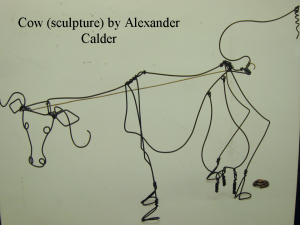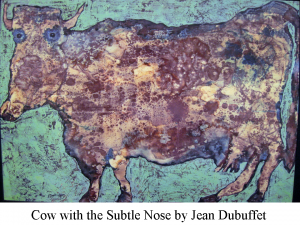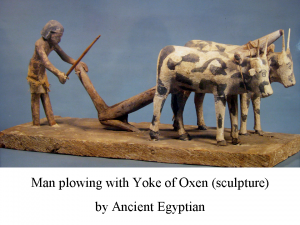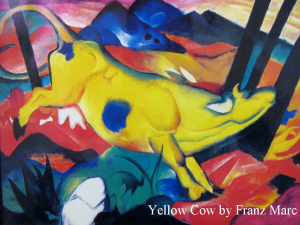I never saw a purple cow,
I never hope to see one,
But I can tell you anyhow,
I’d rather see than be one!
PDF Info:
Packet 2. I Never Saw a Purple Cow
Powerpoint Info:
Packet 2. I Never Saw a Purple Cow
1. Cow (sculpture) by Alexander Calder
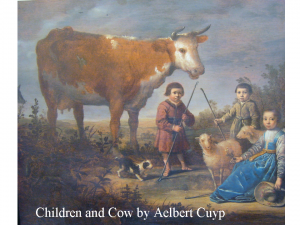
2. Children and a Cow by Aelbert Cuyp
3. The Cow with the Subtle Nose by Jean Dubuffet
4. Man Plowing with Yoke of Oxen (sculpture) from Ancient Egypt
5. Yellow Cow by Franz Marc
6. Black Cow from Lascaux Cave Painting
Extra:
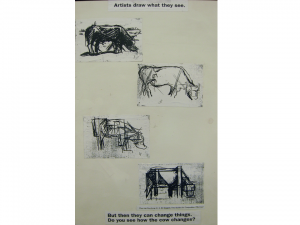
SHAPE has two measurable dimensions—height (up & down) and width (side to side). SHAPES are flat—they have no thickness or depth. FORM has three measurable dimensions—height, width and depth (DEPTH is an object’s thickness).
The unusual “Cow” sculpture, by Alexander Calder, does not have much thickness. It is almost just a SHAPE—an outline, or CONTOUR LINE, representing a cow, created with wire. However, it does have some measurable thickness, which makes it a three-dimensional FORM—a sculpture. The carved Egyptian oxen also have 3-dimensional FORM. The PHOTOGRAPHS of these two sculptures actually have only SHAPE (height & width), but the real sculptures, if they were standing in front of us, are examples of FORM. Since we don’t have the actual sculptures, these photos represent examples of three-dimensional FORM.
All of the paintings in this Packet have the recognizable ORGANIC SHAPE of a cow. Yet, each painting is different because the artists employed their own STYLE. Dubuffet’s and Marc’s paintings are examples of EXPRESSIONISM. These artists did not try to make their cows appear realistic, as in a photograph. They both wanted to create a feeling (MOOD) or make us look twice at their work. Alexander Calder exaggerated the FORM of his cow, to make it appear silly, which is a MOOD. This makes Calder’s sculpture another example of EXPRESSIONISM. The stiff, PRIMITIVE STYLE of the Egyptian sculpture attempts REALISM, but is actually more EXPRESSIONISTIC. The prehistoric cave paintings, along with Cuyp’s painting, are the two examples of REALISM in this Packet (although there is no painted background on the rock and the children, in the second painting, are a little out of proportion).
Yellow Cow uses bright fantasy colors, which causes our eyes to focus on the cow in the center. This cow is also darkly outlined. This outline is a CONTOUR LINE. Children and Cow has COLOR that is more subtle and realistic. Man Plowing with a Yoke of Oxen is an ancient Egyptian sculpture that was realistically painted, almost 4,000 years ago. This ancient sculpture retains its original COLOR. Cow with the Subtle Nose uses “blotchy” applications of paint to create TEXTURE.
The FOCAL POINT or CENTER OF INTEREST (where your eyes go first) in each picture is the cow. Discuss the different ways the artists accomplished this. (COLOR, size, placement)
Be sure ALL 6 pictures are returned to the Packet Carrier after your Presentation is finished.
Presentation Suggestion
You might begin or end you presentation by lining all of the pictures up across the tray at the front of the room. Ask the kids if they can figure out what kind of Art you are going to talk about today. Ask if they can tell you which cows are 2-dimensional painted pictures and which cows are 3-dimensional sculptures. After you finish with the Presentation, you could ask the kids which type of artistic representation they liked best. Remember that there are no right or wrong opinions about art.
Project Ideas
Colored pipe cleaners are available from the district warehouse. Younger kids may like to use these. It takes about 6-8 pipe cleaners to create a wire sculpture of a cow. It is helpful to have kids make a simple line drawing first, to help them figure out how they will use their pipe cleaners.Paddled Florist wire creates a good wire sculpture. This comes in different gauges and colors (gray, green, and silver). It is inexpensive, at most craft stores or the plant sections of most department stores. It is easier to cut sections of wire before you come to class. You can carry them to class inside a sack. Cut about a yard for each student. Bring the extra in case some kids need a little more for detail.K-2 might create a wire cow picture by using a piece of colored paper and colorful yarn. Use a pencil to lightly draw the cow first. Then outline the pencil lines with white glue. Next, use colored yarn and lay along the glue line. This creates a CONTOUR LINE cow. Try to give kids a variety of colors to work with. This type of “wire cow” is much easier for younger kids to add the details of the eyes and nostrils. It is also good for a discussion of LINE, or FORM versus SHAPE. Be sure to explain and discuss these basic elements BEFORE kids begin the project, or they won’t listen.Colored, plastic coated electrical wire would make more colorful wire sculptures. Sometimes you can find this at the dollar stores, if you don’t know an electrician who has some.Put approximately a dozen toothpicks in a small sandwich bag for each student (grades 4-5). Have kids use glue and scissors to create a cow sculpture. Most scissors should cut the toothpicks. Use 3×5” cards to set the sculptures on for drying. Be sure kids write their names on the card. Challenge class to be creative in making the most “unique” cow. Details like ears, eyes, and utters could be added with paper or paint (after the glue dries).Create a cow sculpture using clay.Carve a cow sculpture from a bar of soap, using a plastic knife.Create a cow puppet from a sock, a paper sack, or a paper plate.Create a papier mâche cow puppet head. This will take at least two sessions to complete. Use half of a toilet tissue tube for the base. Crumple newspaper into a ball and use small pieces of masking tape to secure it to the tissue tube ring. DO NOT COVER THE ENTIRE SURFACE OF THE PAPER WITH THE MASKING TAPE, or the papier mâche will not stick. Add a small ball of paper to the front for a snout. Create a base for the ears and the horns with tag board. Mix wallpaper paste or flour and water in a bowl with pieces of shredded newsprint. Allow these to soak while you give your presentation. This will make them soft and easy to use after the kids have created their cow form. Check, to be sure the class has covered their forms correctly. Allow these to dry for a couple of days. Paint with acrylics when completely dry. Use a handkerchief to cover the hand. Stick two fingers into the toilet tissue ring to move the head.Color or paint a cow outline (included in the packet) using an expressionistic style and a realistic style. The city of Portland sponsored a fundraiser in which sponsoring groups of people bought white, fiberglass cow sculptures and artistically decorated them for an auction to benefit children. Participants came up with some very original and crazy artistic creations! How creative are you?
Cow
(1929)
By Alexander “Sandy” Calder
“…Sculpture must be a joy to look at.”
-Alexander Calder
About the Artist
Alexander “Sandy” Calder was born on July 22, 1898, in Lawton, Pennsylvania. Lawton is now a suburb of Philadelphia. “I always thought I was born on August 22, 1898—at least that was what my mother told me,” Alexander Calder said. “…In 1942, when I wrote to Philadelphia city Hall, enclosing one dollar, to get a birth certificate, they told me I was born July 222, 1898. I sent them another dollar, asking them to have a second look, but they stuck by their first statement…”
Calder was born into a family of artists. His grandfather and his father had both been respected sculptors. In 1994, his grandfather made a sculpture of William Penn, the Quaker founder of Philadelphia, which still stands at the Philadelphia City Hall. Calder’s father produced sculptures for many U.S. cities, including the statue of George Washington (1918) in New York’s Washington Square. Sandy’s mother was a professional Portrait painter. Although his parents and grandfather were artists, sandy didn’t study art in college. Instead, he earned a degree in Mechanical engineering. Engineering seems far away from an artistic career but his engineering expertise helped him figure out how to make his wire and mobile sculptures balance correctly. Yet, Calder was born to become an artist. In 1923, Sandy finally turned to art and began to study painting at the Art Students League, in New York City. There he figured out quickly that it wasn’t painting, but sculpture, the he really loved.
Alexander Calder loved to laugh and tell jokes. He was never alone and everybody loved him. Calder’s imagination was dazzling and his creations were full of fun, humor and poetry. He had a joy for life. Sandy loved the color red and usually wore a red shirt.
Calder created many different sculptures using only wire. He would bend the wire to create a picture, much like a pencil would draw a picture on a piece of paper. Calder made an original contribution to sculpture with his wire figures. He created portraits of many of his friends in this medium (wire-the material he used to create his art). Calder always had a pair of pliers in his back pocket, ready to do another wire sculpture or portrait.
In October 1976, the Whitney Museum, in New York, opened a major exhibit of Calder’s works. The show was called Calder’s Universe. A short time later, on November 11, 1976, Alexander died unexpectedly, from a heart attack. The Whitney exhibition became a living memorial to him. At his funeral, an art historian made a very special personal eulogy: “We will miss his dancing and his gruff sleepy-bear character, as well as his eternal red shirt, so symbolic of his personal warmth. But the sense of rhythm, the sense of fun and the capacity for enjoyment, which were essential elements of his life as well as his art, will remain always for us who knew him.”
About the Art
This wire sculpture is 6 ½” tall and 16” long. It is mostly empty space outlined with thin wire, which forces us to see a goofy looking cow. This sculpture looks like a caricature or a cartoon of a cow. Cow contains all the essential elements that let us know what it is—horns and a familiar type face, a slumped, fragile back, a huge, bony rump, utters (where the milk comes out), funny little hooves and even a cow pie on the ground underneath its upturned, curly tail.
Suggested Dialogue
Although this sculpture is a skinny, wire outline, IS THERE ANYONE WHO DID NOT KNOW WHAT THIS WAS AS SOON AS THEY SAW IT? It is easy to tell what this sculpture is.
DO YOU LIKE CALDER’S COW? Emphasize that there is no wrong answer, just opinions of art.
Children and a Cow
By Aelbert Cuyp
About the Artist
Aelbert Cuyp was born in Dordrecht, the Netherlands, in 1620. Dordrecht, in the Province of South Holland, is the oldest city in the Netherlands. It was an important commercial center in the 1600’s. The Cuyp family was very artistic and found plenty of work for all their artistic skills. Jacob Cuyp, Aelbert’s father, specialized in Portrait painting. Other members of the Cuyp family specialized in Landscape painting or genre (jon-ruh) scenes (paintings of everyday people doing ordinary things). Some of the other artists in the Cuyp family specialized in glass painting.
Aelbert probably studied art under his father but, instead of following in his father’s footsteps, as a Portrait painter, he broke tradition and didn’t choose an artistic specialty. Most Dutch artists of his time chose one type of painting and made a living doing only that. Aelbert was versatile and very good at painting Landscapes with animals, Seascapes, Still Life and Portraits.
Cuyp’s work seems to have three distinct periods. Although Cuyp usually signed his works, he didn’t date them, so art historians have to approximately date his works by a series of similar traits. For instance, his first period, up to the early 1640’s, were smaller paintings. These paintings were usually Landscapes with cattle and people. In the later 1640’s and 1650’s, during his second period, his paintings were usually larger. Aelbert paid more attention to the type of lighting he used during this second period. His Landscapes were usually painted with the soft, gray light of early morning, or the golden light of evening. Cuyp’s last period of paintings, during the 1660’s, seem to be more artificial, with less realistic lighting and details.
During the last 20 years of his life, art historians think Cuyp probably didn’t paint anymore. City records show that he married a rich widow, in 1658, and became a landowner. From 1680-1682, Cuyp was a city official and held several civic offices. He died in Dordrecht, in 1691.
About the Art and Suggested Dialogue
This picture was probably painted during Cuyp’s first period of painting, before he had much experience. The painting is a Landscape. The cow seems very large in proportion to the children. The children have shepherd’s crooks but it would be impossible to imagine these small children getting this giant cow to move anywhere. The children are also dressed too nicely to be herding a cow.
Do the children seem threatened or afraid of the cow? (No, they appear very calm)
Do their crooks look like they would help them steer this cow, or sheep, anywhere? (Definitely NOT, they are excessively small to do any good.)
Notice how the cow, the sheep and the children are watching us from the painting. If you look closely at the faces of the children, it seems that they are grown-ups, not children. The artist seems to have painted adult faces on very small bodies to create these children.
What is the MOOD of this painting? (Calm, relaxing, quiet)
The Cow with the Subtle Nose
(1954—35”x 45”)
By Jean Dubuffet
About the Artist
Jean Dubuffet was born in Le Havre, France, in 1901. Dubuffet was the son of a wealthy wine merchant and was a little bit spoiled. His early interest in art showed talented promise, so his parents sent him to Paris, in 1918, to study art at the Academy Julian. Jean was 17 at the time and Paris held many adventures for a young man, which easily distracted him from his studies. In 1924, Dubuffet gave up the pretense of studying for an art career and returned home to take over his father’s wine business and eventually start his own.
In 1942, after age 40, Dubuffet decided to try an art career again. This time he was serious and truly committed himself to becoming an artist. Jean didn’t like all the rules of the formal art world though. He felt the artwork of children was refreshing because kids didn’t have to follow any of the rules that the traditional art world taught about materials, shape and color. Jean thought children’s artwork showed a vitality sense of fun that had been lost from traditional art. He thought children’s artwork looked better because they didn’t have to follow any rules so their art was what real art was supposed to be about. In 1947, Dubuffet coined the term “art brut” (French for “raw art”) to represent this original type of art, which was not restricted by rules. Although he was not a child anymore, Dubuffet studied children’s art and learned to relax and forget about all the rules he had learned in art school. He felt that children’s art created a direct experience for the viewer. He became an artist who ignored all the formal art rules and did just what made him feel good and happy about creating art.
About the Art
When you first look at this painting, it seems like a child could have painted it. The blotchy application of paint and the outline of the cow are extremely simplified. Dubuffet didn’t try to make this cow look real at all, yet we still know that it IS a cow as soon as we see it. This cow has a long face and her nose looks something between a pig snout and a shortened elephant trunk. The ears/horns of the cow stand at attention. So does the cow’s slightly raised tail. It seems that somewhere in this textured green environment, some smell or movement has alerted the cow. She stands at attention, using all her senses to “nose out” the distraction. Are we bothering this strange beast and invading her world as we stare at her?
Project Idea
Draw a simple, heavy outline (contour line) of a cow, with a dark crayon on white paper. Make the cow fill most of the paper. Wet the paper and paint the cow with watercolors. Use one color or several colors to paint your cow (remember—most cows have spots and you can make your cow have different colored spots, if you want). While the paint is still wet, sprinkle a small amount of salt on the paper. Let the paint dry and brush the salt away. This will make the cow appear blotchy.
· Wet a piece of white paper and paint the entire page with watercolor. Sprinkle salt on the paper. After the paper is dry, draw a simple outline of a cow on the backside of the page, with a light pencil. Cut out and glue the cow (painted side up) to a piece of green construction paper. Outline the edge of the cow with colored yarn. You could paint a “purple” cow. Younger kids often copy things from the board to practice writing skills. Younger kids (1-3) could attach a piece of paper that they have copied the purple cow poem on. Talk to the teacher about this ahead of time.
Man Plowing With a Yoke of Oxen
Unknown Egyptian Sculptor
XI Dynasty, (2050-1788 BC)
This painted wooden sculpture is about 4,000 years old. It was found in an ancient Egyptian tomb. Ancient, wealthy Egyptian people built fancy tombs, filled with many riches and luxuries, in preparation for their death. After they died, the Egyptians believed that they went to a different world to live and their material possessions (the “things” they owned in life) went with them. Beautiful and ornate furniture, pottery, glassware, jewelry, clothing, baskets, and religious objects have been found in Egyptian tombs. Because of the dry desert air, many of these ancient relics are still in good condition. We know more about the Egyptians than any other ancient culture because so many of the things they put in their tombs have survived for us to see today.
Egyptians believed that small statues of servants, buried in the graves of the deceased, would become their REAL servants in the next world and make life more comfortable for them. Wealthy Egyptians could afford to hire artists to create many of these statues to be buried with them. The statues often showed people doing every daily event of this ancient culture. If a rich Egyptian had many servants who tilled his fields, cooked his food, built his furniture, made his jewelry, cared for his gardens, wove his cloth and took care of his animals, he would want to have these same comforts in his next life. The Egyptian would hire an artist to create small statues of his many servants doing all of these important jobs for him. After he died, the statues would be buried with him and magically become real in the next life so that he would be comfortable and well off again. These sculptures were carved and painted to duplicate the clothing, hairstyles, animals and equipment used in real ancient Egyptian life.
This carved and painted statue shows us that the Egyptians were skilled in agriculture. Egyptians grew most of their food, along with the plants they used to weave cloth. The two oxen that pull this plow look realistic. Oxen are cousins of cows and look very much like them. The plow is dragged behind the oxen and it digs into the dirt to get the field ready for planting seeds. The farmer directs the oxen by using a stick, in case the oxen decide to stop. Farmers have plowed their fields, in much the same way, for thousands of years. American Pioneer farmers, from the 1700’s until the mid 1900’s, plowed their fields the same way as ancient Egyptian farmers. Today, most farmers use tractors, but in some countries, farmers still don’t have tractors and most use a plow with oxen, just like this picture. The farmer has a sheet draped around his waist for clothing. His hairstyle looks like a modern “page-boy” haircut. This statue appears very much like the carved, wooden toys created by early American Pioneers.
Look for books with pictures of carved pioneer toys to show class. Have kids compare the toys with this sculpture. How are they similar? How are they different? Were any of the same techniques used to create the pioneer examples and the ancient Egyptian examples?
Yellow Cow
By Franz Marc
About the Artist
Franz Marc was born February 8, 1880, in Munich, Bavaria (Germany). His father was a painter but Franz chose to study theology and philosophy, instead of art, when he went to college. At the age of 20, Franz suddenly decided to be a painter and entered the Munich Academy to study painting. There Franz began to explore ways to express himself in paint. In 1903, Marc made his first trip to Paris, where he studied the styles of many modern painters.
During the early1900’s, Germany was very prosperous and was experiencing rapid industrial growth. Franz Marc believed many of the German people were obsessed with power and money. He was depressed with the greed that surrounded him in Germany. Mac searched for the meaning of life in nature. He believed that animals had a special, innocent power that humans couldn’t spoil. Marc liked to imagine the world as it might look to a horse, a deer, or a cow. He is best known for his animal images that are the expression of his deep union with all creation. Marc created a visual language, using colors and shapes, to express his idea of the natural strength, courage and goodness of animals. The colors he chose weren’t the natural color of animals. He chose radiant, bright colors that gave the creatures in his paintings independent and joyful life. He pictured a world in which ordinary objects had extraordinary colors. Franz said, “I should like meadows colored red and trees colored blue”. (A view held by many Expressionists who felt it more important to create a certain MOOD than realism.)
Marc joined the army when World War I began. He stopped painting but kept a sketchbook while he was in the army. On March 4, 1916, Franz was killed on the battlefield, at Verdun. He was only 36.
About the Art
Can you see the cow in this colorful painting? What is the MOOD of this painting? The cow seems to be happy and smiling, while it is dancing and jumping around. The bright, bold colors make it seem like there is a love of movement and excitement.
How do you usually imagine a cow, when you picture one in your mind? How is this cow different? Cows are usually quiet, boring things that stand in fields, eating grass, or lay on the ground, chewing their cud. It isn’t very often that people see a cow run or walk fast.
Have you ever seen a dancing cow? How many of you have ever seen a real cow that was the same color of Franz Marc’s cow? Franz Marc always painted his animals with radiant, bright colors that made them seem independent and joyful. Cows are usually brown, black, and white, spotted brown and white or black and white. This cow is bright yellow, with bright blue spots.
Can you find the blue mountains in the background? Can you figure out what the rest of the foreground and background colors might represent? The artist has painted the bright colored cow as the FOCAL POINT of this painting. The cow fills most of the picture. The way the artist has painted the background gives an illusion that it might be soft and spongy, like a mattress or trampoline. A dancing cow would be hefty, so the artist might be showing us the reason WHY cows don’t normally dance. Notice that Marc “colored the meadow red”.
Project Ideas
Write a story about this cow and why she is dancing. What wonderful thing has happened? Does the cow have any other animal friends? Who are they? What strange color are they? Do they have colored spots or stripes? Make her other animal friends part of the story too. Maybe the story could explain why the cow is yellow with blue spots. After the story is written, draw a color picture to illustrate it.Paint a colorful picture with many dancing animals. How about a yellow pig in a purple tutu?
Black Cow
Cave of Lascaux (loss coe), France
(Circa 15,000 BC)
In September of 1940, four teenage boys, living in the Dordogne region of France, made one of the 20th century’s greatest discoveries. While looking for a lost dog in the area around the Lascaux Manor house, they unexpectedly unearthed a network of caves that had once been an important site for prehistoric humankind.
In the Lascaux caves, during the Paleolithic Era or Old Stone Age, Cro-Magnon Man, one of our early ancestors, had decorated the rough walls of the caves with an amazing group of paintings. These paintings of four-legged animals are an amazing link to past prehistoric artists!
The Paleolithic period spanned the years from 20,000 BC to 10,000 BC. The people who lived during this time were traveling hunters and food gatherers. These people knew about fire and often lived in the mouths of caves for protection from cold weather. Many caves, with artifacts from these ancient people, are scattered all over Spain and France. The most interesting thing about the caves is that deep inside the darkest areas of the caves, away from the openings where the people actually lived, prehistoric artists left their mysterious marks.
The Axial Gallery is part of the huge underground site at Lascaux. The gallery is a winding corridor, 20 yards long and about 13 feet high. It is entirely shut off from any natural light. Ancient people used stone lamps, which burned animal fat, to see in this pitch-black section of the caves. These Cro-Magnon people constructed scaffolding, which allowed them to decorate the high, rough walls of the Axial gallery. The paint they used was made from yellow, red or black colored clay, iron oxide and other colored minerals. The clay and minerals were dug from the earth, ground to powder between two stones, and mixed with animal fat, spit, egg or blood, to form paint that was extremely durable.
Before they were painted, the walls were carefully cleaned. Then the paints were applied with fingertips, fine animal hair or moss brushes. The prehistoric artist was very selective in his choice of natural backgrounds. If a curve in the rock suggested the bulky shoulders of a bison, this only made his painting more realistic. The artist who painted Black Cow had this same idea in mind. The cow has her upper body painted in an indent in the rock and her front legs dangle over a small ledge. This creates the impression that the cow is trying to find her balance. Also, there is a sharp angle between her two front legs, which helps to create a realistic illusion of DEPTH, as if one leg were behind the other. The center of the cow’s bulky body has a reddish stain. It makes us wonder if this is an animal that has been felled by a hunters spear. Are those faint lines, leading from the cow’s body, the artist’s statement of man’s domination over his animal prey?
Many questions still remain concerning the actual significance of Black Cow and her other animal friends. Some scholars think the images were lucky charms, painted on the cave walls to insure a successful hunt. Others think that many of the animals weren’t used for food or clothing and that the cave walls were like books that told stories about the creation myths of these people. Some scholars think that the grid-like pattern, directly in front of Black Cow and others just like it, which appear throughout the network of the caves, might be part of an ancient written language. If they could be decoded some day, the same way as ancient Egyptian hieroglyphs, they might give us valuable information about this ancient and mysterious world.
In 1963, the Lascaux caves were closed to the public. After the paintings had survived intact, for close the 15,000 years, pollution from the modern world began to attack and disintegrate these important paintings. Today, life-size models, films and photographs allow the modern world to see this ancient marvel!
Suggested Dialogue
Explain how dating BC (or BCE—Before the Common Era) and AD are different. Explain this by drawing a number line, which includes the Paleolithic period (from 30,000 to 10,000 BC) and finishes with the present AD year. The division between BC (BCE) and AD is represented by the number zero on the number line. BC (BCE) years are represented with negative numbers, which get smaller as they approach the number zero. We are now just barely 2,000 years past the year AD 1. Modern dates are in the AD time and these positive numbers get larger as we move farther away from the year AD 1. People who lived during the BC years did not keep track of the years this way. Using BC and AD is the way modern scientists developed a clearer way to organize the many, many years of the past.
Remember that AD comes before (AD 2005) the year number
BC comes after (2000 BC) the year number.
Older kids (4th, 5th grade) will understand this number line explanation better. Younger kids just need to know that the ancient cows were created a long, long, long, long, long time ago!
Have kids do a math problem or two, comparing how far apart in history some of these different cows were painted and sculpted.
If you create a visual timeline, you could include some of the major achievements of man (pyramids of Egypt, Wright Brothers first flight, invention of television, first moon landing) to compare with the distant time period this ancient cow was created in.
The DATE a piece of art was created is usually listed with an artist’s name. Alexander Calder created his Cow sculpture in 1929 and Dubuffet’s Cow was painted in 1954. By knowing the period of history that a work of art was created in, we can better understand what influenced an artist’s particular STYLE or SUBJECT MATTER. Often it helps us understand the art better when we are able to understand what existed in the artist’s culture at the time.
Sometimes there will be two dates (1888-1889) listed. This means the artist began the work in a certain year and it took until the second date for him to finish it.
“Circa” (also represented by ca. or c.) is often listed along with a date. Circa means “approximately”.
Project Ideas
Bring in enough large, flat rocks for everyone to paint their own “rock art” cow. You could use the same ancient colors that were used for this cave painting (black, white, red ochre or burnt sienna and burnt umber), or you could use modern, fluorescent colors to paint a modern rock art cow. Acrylic paints work best for painting on rock, because the paint will not flake off. Acrylics are inexpensive and water soluble but don’t come out of clothes. Acrylics are not recommended for younger kids but 4th and 5th grade can manage well if you stress caution! Ask kids ahead of time to bring in an old painting shirt. Small squares of waxed paper, or paper plates, work well for paint palettes when using acrylics. Squirt about a dime size spot of each color. Two kids could share a palette of paint.
Red rock (used for landscaping) makes realistic prehistoric paint when crushed with a hammer and mixed with a little vegetable oil. It takes awhile to crush enough rock for a class so this idea depends on how authentic you wish to be. It only takes a handful of rocks, but you need to crush them into a fine powder. This paint can be spread on construction paper (with fingers) to paint a prehistoric “Red Cow”! Crushed charcoal briquettes, mixed with vegetable oil, will paint a prehistoric “Black Cow”.
I Never Saw a Purple Cow
Project Ideas
(Thank you for sharing these Kelly Brachman)
Clay Pot Cows – using a small Styrofoam cup turned upside down; glue a small round Styrofoam ball to the bottom of the cup. Draw a cow’s face and spots with markers. Cut out ears, horns, and feet using craft foam. Cute project!
A Moo-ving Masterpiece – Draw a Landscape of a grassy hillside on white construction paper and color or paint. Follow easy cow drawing instructions and draw and cut out a cow. Cut a straight line across hillside paper near bottom edge. Glue cow to craft stick and slide into the cut out section on the paper. Now your cow can graze across the picture!
Use a paper bag, craft foam, markers, or anything else you can think of to make a cow puppet. You can use a template like the one above if you like.
Make a barn scene inside of a shoe box using colored construction paper, yarn, craft foam, buttons, etc.
Draw a Cow by Combining
a few
Basic Shapes!
Color or paint this cow in an Expressionistic Style!
Color or paint this cow in a Realistic Style!

